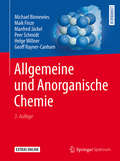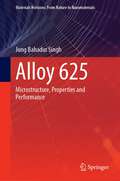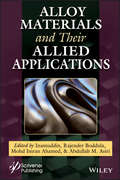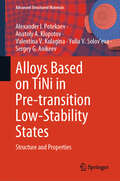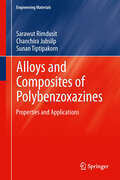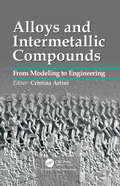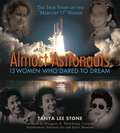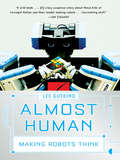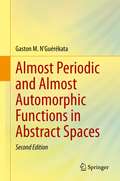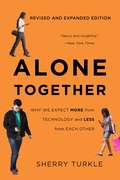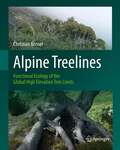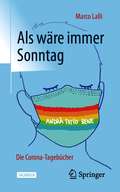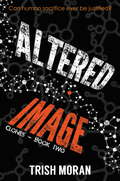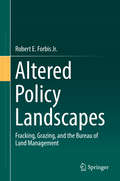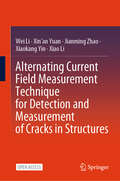- Table View
- List View
Allgemeine Grundlagen des Bauwesens: Technik – Organisation – Wirtschaftlichkeit (Handbuch für Bauingenieure)
by Konrad ZilchDer vorliegende Band aus der Reihe Handbuch für Bauingenieure erläutert wichtige grundlegende und aktuelle Inhalte der Fachgebiete Ingenieurgeodäsie, Bauphysik, Bauchemie, Bauinformatik, Theorie der Tragwerke und Zuverlässigkeit von Tragwerken. Die Vorhersage des Verhaltens von Tragwerken unter den unterschiedlichen Beanspruchungen stellt eine Kernaufgabe entwerfender Ingenieure dar und liefert die Basis für die Dimensionierungsaufgaben im Konstruktiven Ingenieurbau. Die hierzu erforderlichen Theorien und Modelle der Geodäsie, Bauphysik und der Tragwerke sowie deren Umsetzung in Analysemethoden werden in den Kapiteln schrittweise aus den Grundlagen der technischen Mechanik bis zu Berechnungskonzepten und deren algorithmischen Umsetzungen entwickelt. Ein wesentliches Ziel dieses Buches ist es, dem Leser die Fähigkeit zu verleihen, die gewonnenen Ergebnisse in die Anschauungswelt seiner Entwürfe und Konstruktionen zu übertragen, um sie dort nachvollziehen zu können und stets kritisch zu hinterfragen.Das Handbuch für Bauingenieure bietet Grundwissen kompakt, vollständig und aktuell. Neben den klassischen Fächern des Konstruktiven Ingenieurbaus zählt dazu verstärkt das Fachwissen über das Bau-, Immobilien- und Unternehmensmanagement sowie das Baurecht. Darüber hinaus behandeln ausgewiesene Fachautoren die weiteren Kerngebiete des Bauingenieurs: Geotechnik, Wasserbau, Siedlungswasserwirtschaft, Abfalltechnik, Raumordnung und Städtebau sowie Verkehrssysteme und –anlagen. Das Handbuch wurde den aktuellen Normen und Richtlinien angepasst und versteht sich als Lehrbuch für Studierende und Nachschlagewerk für Praktiker.
Allgemeine und Anorganische Chemie
by Peer Schmidt Michael Binnewies Maik Finze Manfred Jäckel Helge Willner Geoff Rayner-CanhamDieses erfolgreiche Lehrbuch der Allgemeinen und Anorganischen Chemie baut auf der im angloamerikanischen Raum seit vielen Auflagen bewährten Einführung Descriptive Inorganic Chemistry von Geoff Rayner-Canham auf. Die Übersetzung des Werkes ist von den deutschen Co-Autoren Michael Binnewies, Manfred Jäckel und Helge Willner vollständig überarbeitet und wesentlich erweitert worden, um den Text auf die Bedürfnisse der Chemiestudierenden im Haupt- und Nebenfach im deutschsprachigen Raum zuzuschneiden. Für die 2. Auflage haben sie zahlreiche neue Inhalte eingearbeitet, etwa zur Molekülsymmetrie, zu ionischen Flüssigkeiten, zu Biomineralen und Kohlenstoff-Nanoröhren. Viele Abschnitte sind erweitert, etliche Abbildungen verändert oder neu erstellt worden. Das klar gegliederte und verständlich geschriebene Lehrbuch umfasst in einem ausgewogenen Verhältnis eine praxisgerechte Allgemeine Chemie und einen soliden Überblick über die Chemie anorganischer Stoffe. Vielfach werden auch Beziehungen zu den Nachbarwissenschaften Physik und Biologie berücksichtigt. Einen Schwerpunkt im Bereich der Allgemeinen Chemie bildet die Verknüpfung mit den zentralen Inhalten der Ausbildung in den Praktika. Die Präsentation der Stoffchemie im zweiten Teil des Buches folgt dem Periodensystem und geht dabei überwiegend exemplarisch vor. Im Vordergrund steht hier das Verständnis für die Eigenschaften der wichtigsten Stoffe und ihre Anwendung in Labor, Technik und Alltag, nicht eine (tendenziell enzyklopädische) Stoffsystematik. Der Zusammenhang mit grundlegenden allgemein-chemischen Konzepten wird sorgfältig herausgearbeitet. Zahlreiche Exkurse geben nähere Einblicke in aktuelle Technologien, in wissenschaftshistorische Zusammenhänge und Umweltprobleme. Eigene Kapitel zu den Grundlagen der Physik und der praktischen Mathematik ermöglichen eine Rekapitulation naturwissenschaftlichen Basiswissens. Eine umfangreiche Datensammlung rundet das Werk ab. Das Buch ist durchgehend zweifarbig illustriert, umfasst ein Glossar sowie zahlreiche Übungsaufgaben zu jedem Kapitel. Auf der buchbegleitenden Website findet man die Antworten zu diesen Fragen sowie eine Sammlung von Farbfotos, die einen Eindruck vom Erscheinungsbild vieler Elemente, Laborreagenzien und Mineralien liefern. Eine Bild-DVD für Dozenten mit allen Grafiken des Buches ist separat erhältlich, ebenso ein Arbeitsbuch für Studierende mit zahlreichen weiteren Übungsaufgaben zu den wichtigsten Themen der Allgemeinen Chemie.
Alliance Capitalism, Innovation and the Chinese State: The Global Wireless Sector (International Political Economy Series)
by Victoria HigginsThis book analyses how key 'systems integration' technical pressures, and the increasing use of collaborative alliances for market and product development are impacting on the socio technical policy directives of Chinese State leaders and the strategic behaviour of key Chinese high technology firms operating in the global wireless sector.
Allies: An Insignia Novella (The Insignia Novels)
by S. J. KincaidIn S. J. Kincaid's fast-paced and humorous sci-fi Insignia trilogy, the earth is in the middle of World War III when teen gamer Tom Raines is recruited to train with other young cadets as a pivotal member of the elite combat corps, the Intrasolar Forces. At the Pentagonal Spire's training academy, he makes the best friends of his life—fellow government weapons-in-training Wyatt Enslow, Vik Ashwan, and Yuri Sysevich.In this 47-page prequel novella to the series, budding genius Wyatt Enslow—intensely loyal and hyperintelligent if occasionally, hilariously, socially awkward—takes center stage as S. J. Kincaid reveals Wyatt's life before she found her place, and her own inner strength, among her devoted band of friends at the Spire.Praise for Insignia: "The characters are real, funny, and memorable. You won't be able to put this book down."—Veronica Roth, New York Times bestselling author of DivergentEpic Reads Impulse is a digital imprint with new releases each month.
Alloy 625: Microstructure, Properties and Performance (Materials Horizons: From Nature to Nanomaterials)
by Jung Bahadur SinghThis book gives a brief history of the development of Alloy 625 and a detailed account of its physical, mechanical, and corrosion properties. It also addresses different types of microstructural changes the Alloy 625 undergoes at intermediate temperatures; provides details of properties deterioration due to such microstructural changes; assesses the alloy damage during the in-service inspection of plants; and provides criteria for the damage evaluation for various destructive and non-destructive testing. It combines the industrial data and literature together in one place for damage assessment of service exposed Alloy 625 components. This book serves as a guide to practicing engineers in the industry interested in the use of Alloy 625 and in academia for students pursuing advanced courses in materials science. Alloy 625 is a versatile nickel-chromium-molybdenum alloy known for its unique combination of high strength, excellent fabricability and weldability, and outstanding corrosion resistance.
Alloy Materials and Their Allied Applications
by Inamuddin Abdullah M. Asiri Mohd Imran Ahamed Rajender BoddulaAlloy Materials and Their Allied Applications provides an in-depth overview of alloy materials and applications. The 11 chapters focus on the fabrication methods and design of corrosion-resistant, magnetic, biodegradable, and shape memory alloys. The industrial applications in the allied areas, such as biomedical, dental implants, abrasive finishing, surface treatments, photocatalysis, water treatment, and batteries, are discussed in detail. This book will help readers solve fundamental and applied problems faced in the field of allied alloys applications.
Alloys Based on TiNi in Pre-transition Low-Stability States: Structure and Properties (Advanced Structured Materials #216)
by Alexander I. Potekaev Anatoly A. Klopotov Valentina V. Kulagina Yulia V. Solov'eva Sergey G. AnikeevThis book presents the results of research on the regularities during thermocyclic impact on changes in structural-phase states of functional alloys with low-stability or instability in the area of structural-phase transformations. Without clarification of the physical regularities of the influence of thermomechanical impact on the properties of alloys, it is impossible to develop technological processes of processing functional materials; therefore, the book widely uses the results of many years of research by the authors of the book. It is known that critical temperatures and stresses for martensitic transformation, for example, B 2↔︎ B 19′, in NiTi are very sensitive to cycling. The study of structural-phase states, corresponding to changes in physical-mechanical properties of intermetallics in the area of transformations, is a necessary aspect of understanding the nature of the influence of thermomechanical cycling on the properties of functional alloys. This book is dedicated to the fundamental physical aspects of stability, the influence of structural defects on properties and structural-phase transformations of FCC alloys. This book is useful for a wide range of specialists—scientific researchers and engineers, working in the field of materials science and physics of condensed systems, as well as teachers, postgraduates and students, specializing in the field of materials science.
Alloys and Composites of Polybenzoxazines: Properties and Applications (Engineering Materials)
by Chanchira Jubsilp Sarawut Rimdusit Sunan TiptipakornThis book provides an introduction to the unique and fascinating properties of alloys and composites from novel commercialized thermosetting resins based on polybenzoxazines. Their outstanding properties such as processability, thermal, mechanical, electrical properties as well as ballistic impact properties of polybenzoxazine alloys and composites make them attractive for various applications in electronic packaging encapsulation, light weight ballistic armour composites and bipolar plate in fuel cells.
Alloys and Intermetallic Compounds: From Modeling to Engineering
by Cristina ArtiniThis book focuses on the role of modeling in the design of alloys and intermetallic compounds. It includes an introduction to the most important and most used modeling techniques, such as CALPHAD and ab-initio methods, as well as a section devoted to the latest developments in applications of alloys. The book emphasizes the correlation between modeling and technological developments while discussing topics such as wettability of Ultra High Temperature Ceramics by metals, active brazing of diamonds to metals in cutting tools, surface issues in medicine, novel Fe-based superconductors, metallic glasses, high entropy alloys, and thermoelectric materials.
Almost Astronauts: 13 Women Who Dared to Dream
by Tanya Lee StoneNearly twenty years before the first women were allowed into NASA's astronaut program, a group of thirteen women proved not only that they were as tough as any man but also that they were brave enough to challenge the government. Almost Astronauts tells the story of the "Mercury 13" women, who were blocked by prejudice, jealousy, and a note scrawled by one of the most powerful men in Washington. In the end, the inspiring example of these space-age pioneers empowered young people to take their rightful place in the sky and beyond, piloting jets and commanding space capsules.<P><P> Winner of the Sibert Medal
Almost Human: Making Robots Think
by Lee GutkindA remarkable, intense portrait of the robotic subculture and the challenging quest for robot autonomy. The high bay at the Robotics Institute at Carnegie Mellon University is alive and hyper night and day with the likes of Hyperion, which traversed the Antarctic, and Zoe, the world's first robot scientist, now back home. Robot Segways learn to play soccer, while other robots go on treasure hunts or are destined for hospitals and museums. Dozens of cavorting mechanical creatures, along with tangles of wire, tools, and computer innards are scattered haphazardly. All of these zipping and zooming gizmos are controlled by disheveled young men sitting on the floor, folding chairs, or tool cases, or huddled over laptops squinting into displays with manic intensity. Award-winning author Lee Gutkind immersed himself in this frenzied subculture, following these young roboticists and their bold conceptual machines from Pittsburgh to NASA and to the most barren and arid desert on earth. He makes intelligible their discoveries and stumbling points in this lively behind-the-scenes work.
Almost Periodic and Almost Automorphic Functions in Abstract Spaces
by Gaston M. N'GuérékataThis book presents the foundation of the theory of almost automorphic functions in abstract spaces and the theory of almost periodic functions in locally and non-locally convex spaces and their applications in differential equations. Since the publication of Almost automorphic and almost periodic functions in abstract spaces (Kluwer Academic/Plenum, 2001), there has been a surge of interest in the theory of almost automorphic functions and applications to evolution equations. Several generalizations have since been introduced in the literature, including the study of almost automorphic sequences, and the interplay between almost periodicity and almost automorphic has been exposed for the first time in light of operator theory, complex variable functions and harmonic analysis methods. As such, the time has come for a second edition to this work, which was one of the most cited books of the year 2001.This new edition clarifies and improves upon earlier materials, includes many relevant contributions and references in new and generalized concepts and methods, and answers the longtime open problem, "What is the number of almost automorphic functions that are not almost periodic in the sense of Bohr?" Open problems in non-locally convex valued almost periodic and almost automorphic functions are also indicated.As in the first edition, materials are presented in a simplified and rigorous way. Each chapter is concluded with bibliographical notes showing the original sources of the results and further reading.
Aloft! The Story of the First Hot-Air Balloon Flight / Pedaling Through the Sky (Fountas & Pinnell Classroom, Guided Reading Grade 5)
by Giorgio Bacchin Timothy PaulsonNIMAC-sourced textbook
Alone Together: Why We Expect More from Technology and Less from Each Other
by Sherry TurkleConsider Facebook--it's human contact, only easier to engage with and easier to avoid. Developing technology promises closeness. Sometimes it delivers, but much of our modern life leaves us less connected with people and more connected to simulations of them. In Alone Together, MIT technology and society professor Sherry Turkle explores the power of our new tools and toys to dramatically alter our social lives. It's a nuanced exploration of what we are looking for--and sacrificing--in a world of electronic companions and social networking tools, and an argument that, despite the hand-waving of today's self-described prophets of the future, it will be the next generation who will chart the path between isolation and connectivity.
Along Route 6 in Massachusetts (Postcard History Series)
by James A. GayRoute 6 in Massachusetts runs from Provincetown to Seekonk and passes through some of the most beautiful scenery in the state. What had once been a mere footpath for Native Americans, then widened for the use of stagecoaches, Route 6 would be officially designated the “King’s Highway” in 1920. The moniker was extremely unpopular with the local residents, so much so that the governor officially changed the name to the Grand Army of the Republic Highway in 1937. Depicted from the author’s personal collection of postcards from the 1920s to the 1960s, Route 6 winds its way around tiny fishing villages, sand dunes, marshes, beaches, lighthouses, campgrounds, hotels, restaurants, and historic cities. The combination of Route 6 and the automobile would make Cape Cod a world-renowned tourist destination.
Alpha Omega
by Nicholas BowlingStranger Things meets Black Mirror and Ready Player One in this unsettling, near-future science fiction standalone. Something is rotten in the state of the NutriStart Skills Academy With the discovery of a human skull on the playing fields, children displaying symptoms of an unfamiliar, grisly virus and a catastrophic malfunction in the site's security system, the NSA is about to experience a week that no amount of rebranding can conceal. As the school descends into chaos, teacher Tom Rosen goes looking for answers - but when the real, the unreal and the surreal are indistinguishable, the truth can be difficult to recognise.One pupil, Gabriel Backer, may hold the key to saving the school from destroying itself and its students, except he has already been expelled. Not only that - he has disappeared down the rabbit-hole of "Alpha Omega" - the world's largest VR role-playing game, filled with violent delights and unbridled debauchery. But the game quickly sours. Gabriel will need to confront the real world he's been so desperate to escape if he ever wants to leave...
Alpine Treelines: Functional Ecology of the Global High Elevation Tree Limits
by Susanna Riedl Christian KörnerAlpine treelines mark the low-temperature limit of tree growth and occur in mountains world-wide. Presenting a companion to his book Alpine Plant Life, Christian Körner provides a global synthesis of the treeline phenomenon from sub-arctic to equatorial latitudes and a functional explanation based on the biology of trees. The comprehensive text approaches the subject in a multi-disciplinary way by exploring forest patterns at the edge of tree life, tree morphology, anatomy, climatology and, based on this, modelling treeline position, describing reproduction and population processes, development, phenology, evolutionary aspects, as well as summarizing evidence on the physiology of carbon, water and nutrient relations, and stress physiology. It closes with an account on treelines in the past (palaeo-ecology) and a section on global change effects on treelines, now and in the future. With more than 100 illustrations, many of them in colour, the book shows alpine treelines from around the globe and offers a wealth of scientific information in the form of diagrams and tables.
Als wäre immer Sonntag: Die Corona-Tagebücher
by Marco LalliMärz bis Mai 2020: Es sind drei Monate, die die Welt verändern, in denen in Italien Tausende von Menschen sterben und hierzulande das Toilettenpapier aus den Supermarktregalen verschwindet.Die Corona-Tagebücher berichten unaufgeregt aus der Zeit des Lockdowns in einer süddeutschen Stadt. Sie bieten einen ständigen Faktencheck und den Blick über die eigenen Landesgrenzen, vor allem nach Italien, wo das neue Virus sich europaweit zuerst ausbreitet. Sachlich fundiert, sind die Tagebücher gleichzeitig ein sehr persönliches Zeitdokument. Marco Lalli ist Schriftsteller und promovierter Sozialwissenschaftler. Als Statistiker verfügt er über eine umfassende epidemiologische Ausbildung, mit der er die Hintergründe der Corona-Pandemie verständlich erklärt. Er ist zudem bekannt durch seine Ausführungen zum Themenkomplex des autonomen Fahrens.
Altered Image: The Clone Series (The Clone Series #2)
by Trish MoranThe exciting second volume in Trish Moran's acclaimed young adult series exploring humanity, technology, and the problems of growing up in a dystopian future. Perfect for fans of The Giver and the Divergent trilogy.Since their successful fight to be recognised as equal to humans, the Labs - clones from the infamous research 'Centre' - are thriving in the real world, with many going into important jobs and fields of study.Many Labs are now in relationships with Non-Lab humans and, like Lab leader Abel and his girlfriend Ruby, expecting children. It soon becomes apparent that these children - the Hybrids - are equipped with super-human intelligence and skills beyond either Labs or Non-Labs.As the first generation of Hybrids start to grow up, the conflicts between their human and Lab genes and their places in the new world start to take hold, and things are complicated further when a militant group of rogue Labs, known as the Radicals, prove that they're willing to do anything in their quest to create the 'perfect' being - even at the price of human lives...
Altered Image: The Clone Series (The\clone Ser. #2)
by Trish MoranThe exciting second volume in Trish Moran's acclaimed young adult series exploring humanity, technology, and the problems of growing up in a dystopian future. Perfect for fans of The Giver and the Divergent trilogy.Since their successful fight to be recognised as equal to humans, the Labs - clones from the infamous research 'Centre' - are thriving in the real world, with many going into important jobs and fields of study.Many Labs are now in relationships with Non-Lab humans and, like Lab leader Abel and his girlfriend Ruby, expecting children. It soon becomes apparent that these children - the Hybrids - are equipped with super-human intelligence and skills beyond either Labs or Non-Labs.As the first generation of Hybrids start to grow up, the conflicts between their human and Lab genes and their places in the new world start to take hold, and things are complicated further when a militant group of rogue Labs, known as the Radicals, prove that they're willing to do anything in their quest to create the 'perfect' being - even at the price of human lives...
Altered Policy Landscapes: Fracking, Grazing, and the Bureau of Land Management
by Robert E. Forbis Jr.This book documents the United States Bureau of Land Management's (BLM) shift from a rancher-dominated agency to an energy-dominated agency. This shift is analyzed by identifying the conditions under which the expansion of hydraulic fracturing (fracking) in the Rocky Mountain West triggered a political conflict between ranching and energy stakeholder groups. Through scrutiny of federal actions and policies implemented by the Executive Branch between 2004 and 2010, the book sheds light on the emphasis of domestic energy production during this time period, and how the traditional ranching and energy alliance was split by shifting policy interests. The book is meant for policy makers, natural resource agencies, and students and researchers engaged in political science, public administration, and natural resource management. Chapter 1 introduces readers to the case study at hand, and reviews literature on public land agencies and policies. Chapter 2 summarizes the legal history of public land management by the federal government, and the conditions that caused the BLM to favor energy development over ranching in the mid-2000's. Chapter 3 details the role of the Executive Branch (Bush-Cheney administration) in affecting the BLM's domestic energy policies and resource allocation, and chapter 4 analyzes the role of subgovernments in affecting the BLM's motivations too. Chapters 5, 6 and 7 contain first-hand accounts from government officials, state petroleum associations, and ranching supported interest groups to explore the concept of subgovernment stakeholder domination in policymaking, and analyze the similarities and differences between different policy-making elites. Chapter 8 concludes the text by summarizing subgovernment theory, mapping the behaviors of subgovernment actors, and discussing the implications for future political appointees in the direction of land-management agencies like the BLM.
Altered: An Altered Saga Novella (Altered #1)
by Jennifer RushEverything about Anna's life is a secret. Her father works for the Branch, at the helm of its latest project: monitoring and administering treatments to the four genetically altered boys in the lab below their farmhouse. There's Nick, solemn and brooding; Cas, light-hearted and playful; Trev, smart and caring; and Sam . . . who's stolen Anna's heart.When the Branch decides it's time to take the boys, Sam stages an escape. Anna's father pushes her to go with them, making Sam promise to keep her away from the Branch, at all costs. On the run, with her father's warning in her head, Anna begins to doubt everything she thought she knew about herself. She soon discovers that she and Sam are connected in more ways than either of them expected. And if they're both going to survive, they must piece together the clues of their past before the Branch catches up to them and steals it all away.
Altering Houses and Small Scale Residential Developments
by Ann Bridger Colin Bridger'Altering Houses and Small-scale Residential Development' is a practical guide for home owners and those undertaking residential building projects. It is also useful for students and emerging professionals concerned with the built environment, especially small-scale development procedures. Undertaking house alterations can be daunting, not least because considerations of cost, design and method can simultaneously demand urgent and careful attention. In addition, there are regulations and the law to be satisfied, contracts to be entered into and a host of potential problems concerned with the form and condition of the building itself. It is a rare building which is not defective in some way, but putting things right can be very satisfying.The Bridgers' book assumes that many home owners now wish to understand more clearly what goes on when they commission contractors and consultants to convert and adapt their homes. Or course, there are also people who intend to manage a project themselves, while others may undertake work on a DIY basis, and the secret then is getting the right kind of help. This book will be invaluable in either situation because it explains how to perform certain functions yourself, yet clarifies the roles and responsibilities of the professionals who may be needed to help with the processes of buying, altering and selling a house.The economic factors in development are not overlooked since, for people who wish to develop in order to sell or let property, market conditions will be paramount, as will the forecasting and control of costs. This book provides practical guidance on these matters; it avoids theory, but does suggest further reading. It is also highly illustrated with over 100 illustrations clarifying parts of the text.The main theme of this book is altering houses but, in practice, the differences between some alterations schemes and building a new house can be relatively small. As a result, much of the material will be useful for those who wish to acquire a plot of land and undertake a modest residential development.Altering or building houses and selling them can be a complex business, covering a wide range of interrelated factors. This book will make these processes easier.
Alternating Current Field Measurement Technique for Detection and Measurement of Cracks in Structures
by Wei Li Xiao Li Xin'an Yuan Jianming Zhao Xiaokang YinThis open access book serves as a comprehensive exploration of Alternating Current Field Measurement (ACFM), encompassing the foundational theory crucial for subsequent chapters, as well as the design and testing of ACFM probes, instruments, and software. Providing guidance and serving as a reference for ACFM instrument development, the text delves into visualization research in ACFM, offering valuable insights for technical engineering applications. Nondestructive testing (NDT) emerges as a pivotal method for detecting and assessing defects, offering support for safety pre-warning and maintenance decisions in industrial structures. Originating from the 1980s, the demand for an NDT technique arose to inspect fatigue cracks at welded intersections in offshore underwater structures in the North Sea. Conventional NDT methods proved impractical in this distinct underwater environment with quantitative evaluation requirements, prompting the development of the ACFM technique by researchers in the mechanical engineering department at University College London. Over the past four decades, ACFM's theory model, inspection methods, and equipment have undergone rapid advancements, gaining widespread utilization in ocean engineering, the power industry, rail traffic, and special equipment fields. This book encompasses diverse facets, including the global development history of alternating current field measurement technology, core basic theory, signal processing methods, probe instrument development, standardization construction, and engineering applications. Serving as a valuable learning reference for students and offering fundamental theoretical guidance for scientific researchers, it also provides case introductions for engineering applications. The book aims to propel both theoretical research and practical applications of alternating current field measurement technology, contributing significantly to its popularization and widespread application.
Alternating Current Multi-Circuit Electric Machines: A New Approach to the Steady-State Parameter Determination
by Valentin AsanbayevThis book details an approach for realization of the field decomposition concept. The book presents the methods as well as techniques and procedures for establishing electric machine circuit-loops and determining their parameters. The methods developed have been realized using the models of machines with laminated and solid rotor having classical structure. The use of such models are well recognized and simplifies practical implementation of the obtained results.

